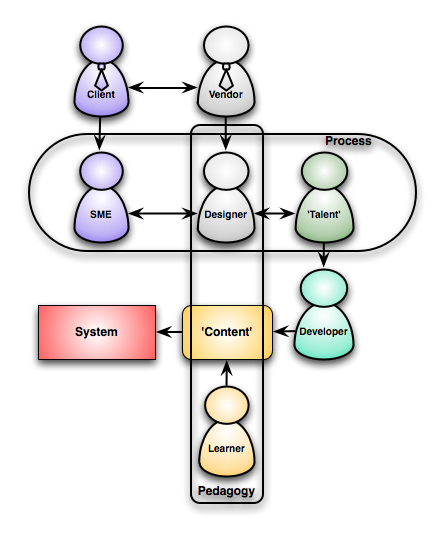What if the learner’s experience was ‘hard fun’: challenging, but engaging, yielding a desirable experience, not just an event to be tolerated, OR what is learning experience design?
Can you imagine creating a ‘course’ that wins raving fans? It’s about designing learning that is not only effective but seriously engaging. I believe that this is not only doable, but doable under real world constraints.
Let me start with this bit of the wikipedia definition of experience design:
the practice of designing…with a focus placed on the quality of the user experience…, with less emphasis placed on increasing and improving functionality
That is, experience design is about creating a user experience, not just focusing on their goals, but thinking about the process as well. And that’s, to me, what is largely ignored in creating elearning is thinking about process from the learner’s perspective. There are really two components: what we need to accomplish, and what we’d like the learner to experience.
Our first goal still has to look at the learning need, and identify an objective that we’d like learners to meet, but even that we need to rethink. We may have constraints on delivery environment, resources, and more that we have to address as well, but that’s not the barrier. The barrier is the mistake of focusing on knowledge-level objectives, not on meaningful skill change. Let me be very clear: one of the real components of creating a learning experience is ensuring that we develop, and communicate, a learning objective that the learner will ‘get’ is important and meaningful to them. And we have to take on the responsibility for making that happen.
Then, we need to design an experience that accomplishes that goal, but in a way that yields a worthwhile experience. I’ve talked before about the emotional trajectory we might want the learner to go through. It should start with a (potentially wry) recognition that this is needed, some initial anxiety but a cautious optimism, etc. We want the learner to gradually develop confidence in their ability, and even some excitement about the experience and the outcome. We’d like them to leave with no anxiety about the learning, and a sense of accomplishment. There are a lot of components I’ve talked about along the way, but at core it’s about addressing motivation, expectations, and concerns.
Actually, we might even shoot for more: a transformative experience, where the learner leaves with an awareness of a fundamental shift in their understanding of the world, with new perspectives and attitudes to accompany their changed vocabulary and capabilities. People look for those in many ways in their life; we should deliver.
This does not come from applying traditional instructional design to an interview with a SME (or even a Subject Matter Network, as I’m increasingly hearing and inclined to agree). As I defined it before, learning design is the intersection of learning, information, and experience design. It takes a broad awareness of how we learn, incorporating viewpoints behavior, cognitive, constructive, connective, and more. It takes an awareness of how we experience: media effects on cognition and emotion, and of the dramatic arts. And most of all, it takes creativity and vision.
However, that does not mean it can’t be developed reliably and repeatably, on a pragmatic basis. It just means you have to approach it anew. It take expertise, and a team with the requisite complementary skill sets, and organizational support. And commitment. What will work will depend on the context and goals (best principles, not best practices), but I will suggest that with good content development processes, a sound design approach, and a will to achieve more than the ordinary. This is doable on a scalable basis, but we have to be willing to take the necessary steps. Are you ready to take your learning to the next level, and create experiences?
 The point is, we have to quit looking at it as design, development, etc; and view it not just as a process, but as a system. A system with lots of inputs, processes, and places to go wrong. I tried to capture a stereotypical system in this picture, with lots of caveats: clients or vendors may be internal or external, there may be more than one talent, etc, it really is a simplified stereotype, with all the negative connotations that entails.
The point is, we have to quit looking at it as design, development, etc; and view it not just as a process, but as a system. A system with lots of inputs, processes, and places to go wrong. I tried to capture a stereotypical system in this picture, with lots of caveats: clients or vendors may be internal or external, there may be more than one talent, etc, it really is a simplified stereotype, with all the negative connotations that entails.